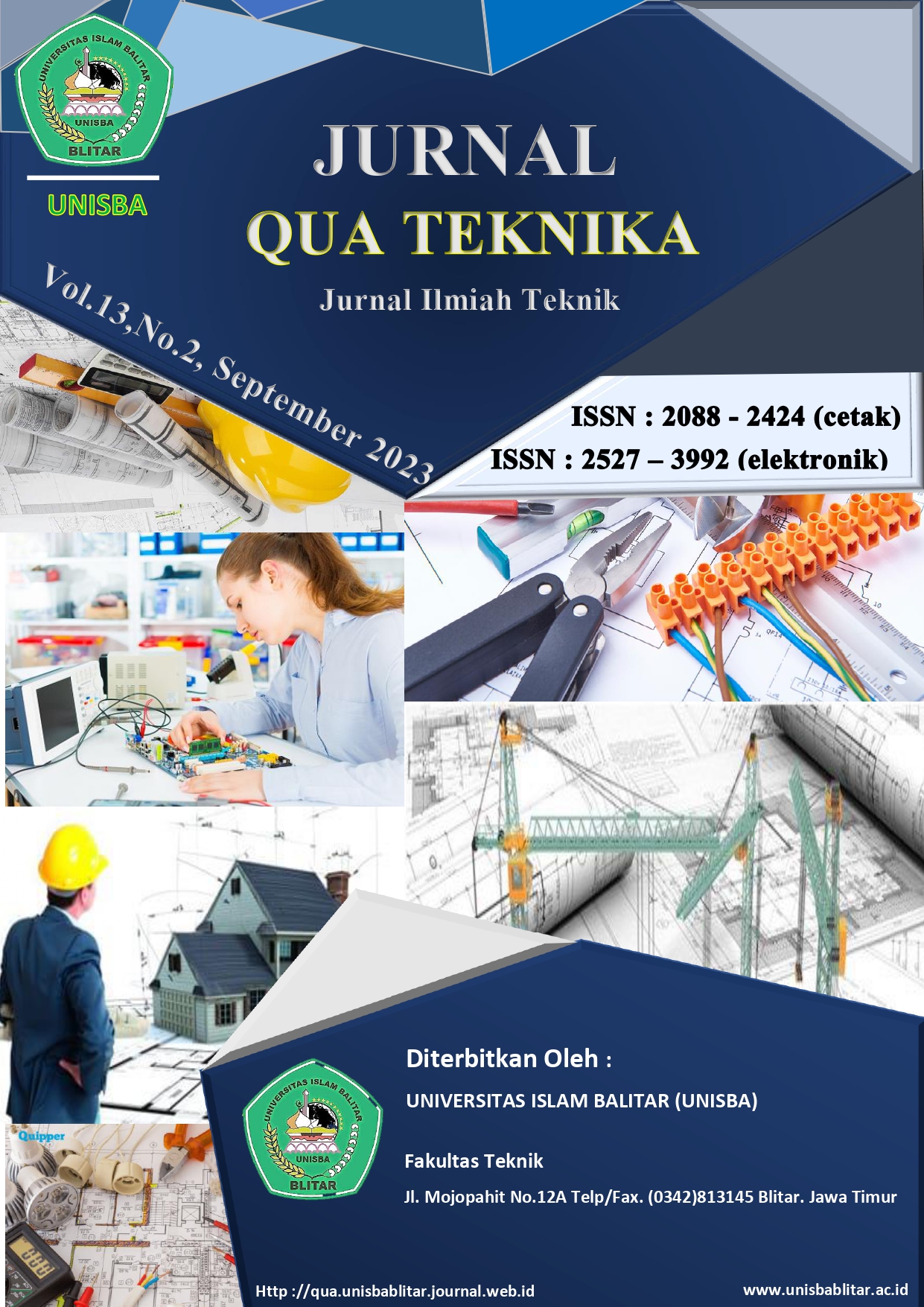ALAT PROYEK MIKRO KONTROL PENGHAPUS PAPAN TULIS OTOMATIS MENGGUNAKAN REMOTE BERBASIS ARDUINO
DOI:
https://doi.org/10.35457/quateknika.v13i2.3161Keywords:
Whiteboard, Infrared Remote, Arduino Uno, Stepper MotorAbstract
The development of automation technology on blackboard erasers can increase the level of
hygiene and health, because with an automation system the activity of erasing the blackboard can be
carried out automatically without inhaling marker ink which has an impact on health and does not dirty
hands. The purpose and working mechanism of making an automatic blackboard eraser using a remote
and Arduino. The method of designing an automatic whiteboard eraser is made using an arduino uno as
a microcontroller and an infrared remote that controls a stepper motor to drive the eraser. The assembly
of the blackboard eraser mechanism is done by preparing a blackboard prototype that has been mounted
on an iron frame. Then, install the top rail and bottom rail. Followed by installing the upper and lower
wheels on the upper and lower rails that have been glued to the eraser clamp. The results of the design of
an automatic whiteboard eraser based on Arduino Uno, can facilitate teachers and students in the
learning process. The conclusion of this design is that the automatic whiteboard eraser can work
according to the program that has been entered into the arduino uno and is controlled by an infrared
remote and the whiteboard eraser working mechanism functions properly to erase the marker ink on the
blackboard with a power of 26.67 watts.
References
Tulis Otomatis Berbasis Arduino Uno,” ILTEK J. Teknol., vol. 15, no. 01, pp. 39–41, 2020, doi:
10.47398/iltek.v15i01.507.
[2] B. I. S. Dawolo, M. Safii, I. Gunawan, I. Parlina, and W. Saputra, “Rancang Bangun Alat
Penghapus Papan Tulis Otomatis Berbasis Arduino Uno Menggunakan Sensor Suara,” J. Penelit.
Inov., vol. 1, no. 1, pp. 11–20, 2021, doi: 10.54082/jupin.3.
[3] S. Winardi, “Rancang Bangun Sistem Pengaman Pintu Rumah Menggunakan Android Berbasis
Arduino Uno,” e-NARODROID, vol. 2, no. 1, pp. 89–92, 2016, doi: 10.31090/narodroid.v2i1.104.
[4] K. Kirilov and I. Ivanov, “A programme for determination of codons and codons context
frequency of occurrence in sequenced genomes,” Biotechnol. Biotechnol. Equip., vol. 26, no. 5,
pp. 3310–3314, 2012, doi: 10.5504/bbeq.2012.0074.
[5] A. H. Patonra, S. Masita, N. R. Wibowo, and A. Fitriati, “Rancang Bangun Media Pembelajaran
Praktik Motor Stepper,” Mechatronics J. Prof. Entrep., vol. 2, no. 1, pp. 7–11, 2020, [Online].
Available:
http://jurnal.politeknikbosowa.ac.id/index.php/JMAPLE/article/view/272%0Ahttp://jurnal.politek
nikbosowa.ac.id/index.php/JMAPLE/article/viewFile/272/127
[6] Z. Hasibuan, Metodologi Penelitian Pada Bidang Ilmu Komputer dan Teknologi Informasi.
Jakarta: Penerbit Erlangga, 2007.
[7] Sucipto, Kusrini, and E. L. Taufiq, “Classification method of multi-class on C4.5 algorithm for
fish diseases,” in Proceeding - 2016 2nd International Conference on Science in Information
Technology, ICSITech 2016: Information Science for Green Society and Environment, 2016, pp.
5–9. doi: 10.1109/ICSITech.2016.7852598.
[8] J. Han and M. Kamber, Data Mining: Concepts and Techniques Second Edition. Oxford: Morgan
Kaufman Publisher, 2006.
[9] S. Sucipto, “Analisa Hasil Rekomendasi Pembimbing Menggunakan Multi-Attribute Dengan
Metode Weighted Product ,” Fountain Informatics J., vol. 2, no. 1, pp. 27–31, 2017, doi:
10.21111/fij.v2i1.912
Downloads
Published
Issue
Section
License
Authors who publish with this journal agree to the following terms:
- Copyright on any article is retained by the author(s).
- Author grant the journal, right of first publication with the work simultaneously licensed under a Creative Commons Attribution License that allows others to share the work with an acknowledgement of the work’s authorship and initial publication in this journal.
- Authors are able to enter into separate, additional contractual arrangements for the non-exclusive distribution of the journal’s published version of the work (e.g., post it to an institutional repository or publish it in a book), with an acknowledgement of its initial publication in this journal.
- Authors are permitted and encouraged to post their work online (e.g., in institutional repositories or on their website) prior to and during the submission process, as it can lead to productive exchanges, as well as earlier and greater citation of published work.
- The article and any associated published material is distributed under the Creative Commons Attribution-ShareAlike 4.0 International License
Deprecated: json_decode(): Passing null to parameter #1 ($json) of type string is deprecated in /home/ejournal.unisbablitar.ac.id/public_html/plugins/generic/citations/CitationsPlugin.php on line 68










